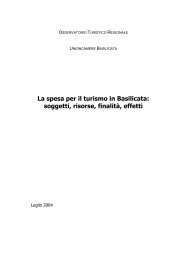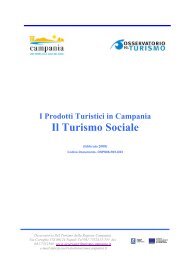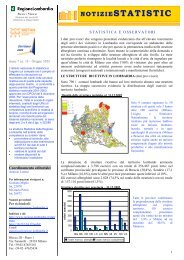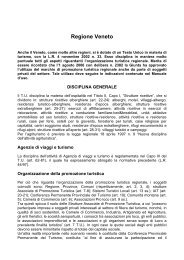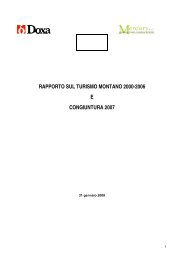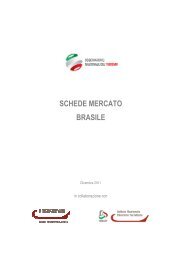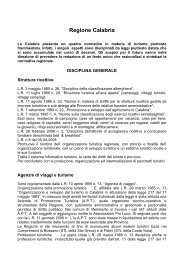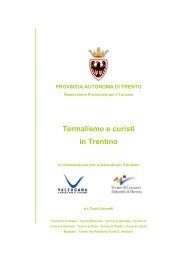analisi dei prodotti turistici - ONT Osservatorio nazionale del Turismo
analisi dei prodotti turistici - ONT Osservatorio nazionale del Turismo
analisi dei prodotti turistici - ONT Osservatorio nazionale del Turismo
You also want an ePaper? Increase the reach of your titles
YUMPU automatically turns print PDFs into web optimized ePapers that Google loves.
184 Moran et al.In contrast to chewing arthropods such as beetarmyworm (Turlings et al., 2000), Manduca spp.larvae (Halitschke et al., 2001), European cornborer (Helicoverpa zea) (Felton and Eichenseer,1999), and Pieris brassicae (Mattiaci et al., 1995),elicitors have not been isolated from aphid salivaor regurgitant. However, the activities of aphid salivaryenzymes and the presence of aromatic compoundsin the saliva suggest roles for several typesof elicitors. Oxidative conditions around the styletsheath and in the phloem could lead to the formationof reactive oxygen species (Miles, 1999;Walling, 2000). These molecules participate in inductionof defenses following plant pathogen infection(Bollwell and Wojtaszek, 1997; Nurnbergerand Scheel, 2001) and wounding (Bi and Felton,1995; Stout and Bostock, 1999). Limited evidencesuggests that oligosaccharides may be released fromplant cell walls and intercellular spaces duringaphid penetration (Campbell and Dreyer, 1990)and feeding (Madhusudhan and Miles, 1998). Oligosaccharideshave elicitation roles in pathogeninfection (Hahn, 1996), wounding (Howe et al.,1996), and chewing herbivory (Stout and Bostock,1999). In the case of aphids, they may act as nonsensesignals to suppress host responses (Miles,1999). Minute changes in turgor pressure and electricalpotential in plant tissues can stimulate defensesignaling in plants (Yahraus et al., 1995;Rhodes et al., 1996). Aphid behavioral studies detectelectrical signals through the use of the EPGtechnique (Tjallingii and Hogen Esch, 1993). Endosymbioticmicrobes play roles in the biosynthesisand action of elicitors related to chewingherbivory (Spiteller et al., 2000). The intimate associationsbetween aphids and symbiotic bacteria(Douglas, 1998) may include a similar cooperativerole.PLANT DEFENSE RESPONSES AND APHID FEEDINGBased largely on information about elicitationmechanisms, recent reviews have hypothesized thataphids induce profiles of genes that bear strongsimilarities to pathogen-inducible gene profiles(Felton and Eichenseer, 1999; Stout and Bostock,1999; Walling, 2000). The limited number of studiesthat have examined the responses of defenserelatedmetabolites to infestation (Table 1) supportthis assertion. Phenolics, their amino acid precursors,biosynthetic enzymes associated with aromaticcompounds, and oxidative enzymes areimportant facets of the plant response profile incereal crops (Table 1). Aphid feeding sometimesresults in localized or systemic necrosis in leaf tissuesof these plants (Miles, 1990, Ryan et al.,1990). Some responses are idiosyncratic to specificplants and aphids. For example, in one set of wheatgenotypes, peroxidase activity increased only in resistantgenotypes of wheat and barley infested withD. noxia, and R. padi feeding had no effect on activityin any genotype (Forslund et al., 2000; Ni etal., 2001). R. padi increases peroxidase activity inother resistant wheat lines (Leszczynski, 1985).Increases in lipid peroxidation and glutathione reduction-associatedenzymes (Table 1) could representstimulation by wounding (Bi and Felton,1995) or elicitors mimicking pathogen infection(Bollwell and Wojtaszek, 1997). Oxidative and reductiveresponses are induced by other phloemfeedinginsects, including three-cornered alfalfahopper (Spissistilus festinus (Say)) on alfalfa (Feltonet al., 1994) and multiple whitefly species onsquash and tomato (Walling, 2000).Induction of pathogenesis-related (PR) genesand proteins, including those with unknown functions(e.g., PR-1 in Arabidopsis thaliana, P4 in tomato)and chitinase and glucanase enzymes, arelocally and possibly systemically associated withaphid feeding in diverse plants (Table 1). PR genesand proteins are common plant responses topathogen infection (Van Loon and Van Strien,1999), although resistance can occur without PRgene induction (Glazebrook, 2001). In cereal crops,induction by aphids involves mostly apoplasticproteins with both basic and acidic pI values, andis often stronger and more rapid in resistant plantgenotypes (Botha et al., 1998; van der Westhuizenet al., 1998a, b; Forslund et al., 2000; but seeKrishnaveni et al., 1999). Work in barley (Forslundet al., 2000), tomato (Fidantsef et al., 1999), andA. thaliana (Moran and Thompson, 2001) has dem-Archives of Insect Biochemistry and Physiology



